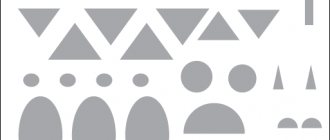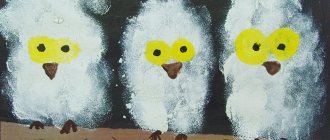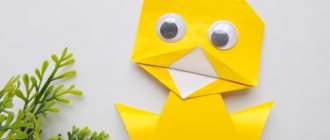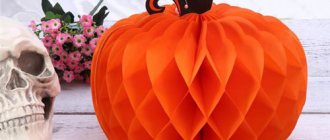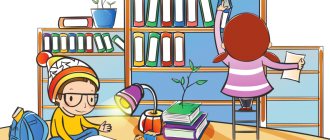Goals and objectives of design classes
The teacher should set himself the task of not only teaching children to perform certain actions, but also implementing their personal craft projects, making them from “waste material”, simply put, from garbage and rubbish. It is construction in the middle group that opens up a huge field of activity for imagination for young creators, teaches kids to achieve their goals, to cherish and appreciate their own and other people’s work.
Every lesson in kindergarten is like a trip to a fairy tale world. And construction in the middle group is no exception in this regard. Therefore, the lesson should begin with a short introduction, a kind of mini-performance in which children should take part, answering questions from the teacher and the characters in the miniature. In this way, children's speech skills and logical thinking are used. Construction in the middle group can involve skills acquired in music classes, when children are asked to sing some song they have learned previously.
Working with scissors, paper and glue
The simplest material for children's creativity is paper. Children begin to create their first masterpieces from it almost from the age of one year. The middle group also enjoys creating from this accessible material. Paper construction is a separate section in planning manual labor classes.
Children happily create crafts as gifts for their families. You can invite them to make a fun frog toy by handing out the part templates first. The teacher should show the kids how the package-body of a cute frog is glued together, how the legs, eyes, and spots are attached. Before this, you can give one lesson to designing the picture “Frog eats a fly” in the middle group.
As you work, you can tell the children a short tale about the sad frog Frog, who considered himself useless to anyone on earth.
“Who knows what benefits frogs bring?” – the teacher should ask. And, by showing a finished sample of the craft, thereby leading the children to the answer: these amphibians destroy insects - mosquitoes and flies - that pester people and animals.
Construction using the origami technique “Fox” for the middle group
Goal: Continue to introduce children to the origami technique. Introduction to basic forms.
Tasks:
Educational: increase interest in origami through play, learn to fold a square in different directions, create compositions with paper products, consolidate technical skills in working with paper.
Developmental: develop attention, memory, fine motor skills and eye.
Educational: to cultivate interest in paper design, to cultivate independence.
Demonstration material: illustrations of a fox, finished craft, finished basic form, orange paper.
Handouts: orange paper for origami, scissors, black pencil for eyes and nose.
Repetition of the rule for working with scissors:
1. Store scissors in a specific place
2. Place the scissors with the sharp ends closed away from you
3. Pass the scissors to each other, rings first
Preliminary work:
Looking at pictures, illustrations, reading stories, fairy tales, poems and guessing riddles on the topic
Organizing time:
The teacher offers to look at a picture of a fox and asks them to tell who is depicted in the picture and what they know about the fox.
Conversation with children.
Educator: The fox is a beautiful animal. Her body is covered with thick red fur. The fox has a luxurious fluffy tail. She has short legs and a sharp muzzle. The fox's eyes are beady and glow with a cunning fire.
Foxes live all over the globe. They live not only in forests, but also in the tundra and steppes.
- Who can tell me, guys, what do foxes eat? - That's right, foxes eat hares, mice, birds, fish, and also like to eat berries, fruits, and vegetables.
Foxes are very careful. In case of danger, they confuse their tracks and hide them in other places. Because of this, the fox is called the most cunning animal.
Foxes live as a small family in a hole they dig in the forest. They have keen eyesight and sense of smell.
Foxes are considered useful animals; they eat small rodents.
Many fairy tales and stories have been invented about the red-haired beauty. What is another name for a fox? (Children’s answers.) That’s right, the guys call the fox “red-haired cheat”, “fox-sister”, “Fox-Patrikeevna”.
- And now, guys, I suggest making everyone their own paper fox, don’t you agree?
First we need to stretch our fingers.
Finger gymnastics:
Let's go for a walk (hands clenched into fists, thumbs running across the table)
And the second ones catch up (index fingers “run” across the table)
Third fingers run (“middle fingers run”)
And the fourth ones walk (“ring fingers walk”)
The fifth finger jumped (touch the table rhythmically with both little fingers)
And at the end of the path he fell (slam his fists on the table).
Practical part:
Creating a fox using origami technique.
1.Fold the paper and cut out a square
2. Take the opposite corners and fold our square in half
3. Bend the end of the triangle to the opposite middle
sides.
4. We bend the left and right side ends upward to create ears.
(The teacher shows the sequence of techniques for folding a figure, draws attention to accuracy in working with paper. If necessary, provides individual assistance.)
- So we have the face of a fox. What is our little fox missing? (Children's answers.) - That's right, of course the nose and eyes are missing. To do this, we will draw them with a black pencil.
But before that, let's have a physical moment with you. (Children get up for physical exercise.)
Physical education minute:
Three nods.
Four - arms wider,
Five - wave your arms.
Six - sit down quietly.
- Guys, now let’s draw our fox’s nose, eyes, and now our little fox is ready.
Lesson summary:
- Guys, what did we do today?
What did you get out of our lesson?
What other animals would you like to learn how to make from paper?
These are our little foxes!
